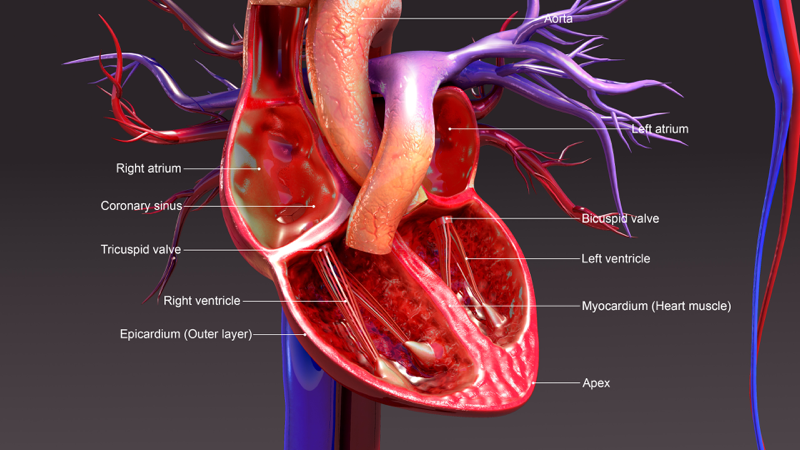
The Daily NCLEX® Challenge is the easiest way to ace your NCLEX exam the first time! Join today, and access 7 days of Premium for free.
Sign up now to receive your first challenge →
When it comes time to your preparation for NCLEX questions, cardiac NCLEX questions always seem to make nursing students anxious. Interpreting electrocardiograms (ECGs), cardiac markers, and labs can feel like a lot on top of understanding the various cardiac terminologies.
That’s why we’ve condensed that information into a digestible cardiac NCLEX questions study guide. No more biting your nails and hoping you studied the right things. With this guide, you can gain a firm grasp on what you should study to increase your odds of NCLEX success.
Let’s begin with a breakdown of the cardiovascular system and the various terms used. Next, we’ll dig into cardiac biomarkers and how to interpret ECG readings so you can feel confident facing these NCLEX questions. And last but not least, we’ll finish with some practice cardiac NCLEX questions with detailed answer rationales to get you on the road to passing the NCLEX.

The cardiovascular system is comprised of the four heart chambers, the great vessels, and the vascular networks that pump blood throughout the entire body. A solid foundation of this basic cardiac knowledge is imperative for correctly answering your cardiac NCLEX questions.
Blood flows into and out of the heart through large vessels called the great vessels. These include:
There are also smaller vessels located outside of the heart. Oxygenated blood leaves the aorta to be pumped into arteries, then moves into arterioles and capillary networks within organs and tissues. The deoxygenated blood flows from veins and venioles and is then pumped back into the heart to be reoxygenated.
A quick tip: Use the phrase “arteries and away” to remember arteries bring oxygenated blood away from the heart. Veins bring deoxygenated blood back. Little tricks like this help prepare for the NCLEX exam and cardiac NCLEX questions.
The heart’s four valves inside of its vessels and chambers keep blood from backflowing and encourage the proper flow of blood. Each valve has cusps or leaflets that open and close during each contraction. These valves include the following parts:
Both the tricuspid valve and aortic valve have fibrous chordae tendineae on their leaflets. The chordae tendineae attach to papillary muscles to hold the valves in place during contractions.
The heart wall is made up of the following layers:
In addition, the heart is covered by a thin, tough sac called the pericardium that separates the heart from other structures and organs. This thin sac has fluid between it and the epicardium (which lubricates and prevents friction between the two layers). Your cardiac NCLEX questions on the exam will likely include complications associated with the layers of the heart such as pericarditis.

So much of cardiac nursing requires interpreting an ECG. That’s because an ECG, combined with laboratory values and assessments, can give a clearer picture of what’s happening with your patients and help you answer cardiac NCLEX questions.
An ECG shows us the electrical activity of each heartbeat or contraction via a waveform. And a waveform has a P, Q, R, S, and T. Let’s discuss each one.
You may also hear about the PR interval. This just refers to the time it takes for the sinus node to send an electrical signal to the ventricles. The sinus node is located in the right atria of the heart and maintains a proper flow of blood through contractions. This electrical impulse travels to the atrioventricular node to further contract the heart.
An ECG tells us if the patient is experiencing a normal sinus rhythm, sinus bradycardia, sinus tachycardia, or irregular rhythms such as atrial fibrillation or ventricular fibrillation. This entire cycle makes up a complete cardiac cycle.
Knowing what each part of an ECG represents leads to better patient care and a better shot at answering your cardiac NCLEX questions correctly. When you understand ECGs, you will more likely know how to treat concerning patterns and what steps to take next.
Let’s discuss the various laboratory values that will help you not only answer cardiac NCLEX questions but also prepare you to care for and manage your cardiac patients.
There are some unique cardiac lab values called cardiac biomarkers. Make yourself very familiar with these in order to prepare for the cardiac NCLEX questions. These values indicate how stressed or damaged the heart is. These values include:
Some other lab tests that help diagnose cardiac problems include:
Here are a few non-laboratory cardiac tests to be aware of on cardiac NCLEX questions:

Now that you understand some cardiac nursing basics, let’s dive into how to care for these patients. Many NCLEX questions want you to prioritize care. To do that correctly, you need to know what you’re looking for. Here is a basic overview of how to assess and manage cardiac patients:
Now it’s time to put your knowledge to the test and answer some cardiac NCLEX questions. Each practice question comes with an answer rationale. So first, answer the question. Then, see if you’re correct by reading the answer and rationale. There are many types of NCLEX questions, so be sure to review all types before the big exam.
Cardiac NCLEX Question #1
An 86-year-old patient who has chronic heart failure is brought to the emergency department in ventricular tachycardia. Further testing shows the patient is also experiencing decreased cardiac output and increased preload. The patient is then placed on digoxin. What discharge teaching should you not give this patient in regards to digoxin?
Answer: D — This is wrong because if the patient’s pulse is outside of 60-100 beats per minute, it could be a sign of digoxin toxicity. All other options are part of routine patient teaching for digoxin.
Cardiac NCLEX Question #2
A patient with a history of coronary artery disease is on a walk when he begins to feel chest pain. He immediately takes sublingual nitroglycerin. In minutes, he begins to have increased chest pain, clammy skin, and blurry vision, so he calls 911. You are his nurse when he arrives at the emergency department. What is the most important nursing intervention to do first?
Answer: C — The first priority for a patient likely experiencing a myocardial infarction is to increase myocardial oxygenation. Without adequate oxygenation, tissues and organs aren’t perfused and death can result. It’s important to decrease a patient’s anxiety, administer nitroglycerin to encourage vasodilation if ordered, and get an ECG reading. But before any of that can occur, oxygenation must be increased. Administering Lasix (furosemide) isn’t a priority at this time.
Cardiac NCLEX Question #3
What’s the first thing you should do for a patient going into ventricular fibrillation?
Answer: A — This patient needs immediate defibrillation, as ventricular fibrillation is a dysrhythmia that results in death. CPR will then be initiated if the patient doesn’t revert to normal sinus rhythm. The patient may then need oxygen. Placing the patient in Trendelenburg isn’t a treatment for ventricular fibrillation.

Now that you know what to expect on the cardiac NCLEX questions, it’s time to incorporate NCLEX practice questions into your daily study routine.
Our Daily NCLEX Challenge is in your corner to help you reach your full test-taking potential. After you sign up, you’ll get a free NCLEX question sent to your email each day so you don’t need to hunt for questions on your own. This gets you in an NCLEX mindset and prepare for the exam
Want to kick it up a notch? Try our premium version to compete against other student nurses and get the chance to win prizes. Plus, you’ll get access to answer rationales and your own personal question bank.
Enhance your studying today with the Daily NCLEX Challenge.
We created some fluid and electrolytes NCLEX questions with a detailed study guide to help you focus on this specific area of nursing knowledge.
Continue readingToday, we’re going to discuss how to study for endocrine NCLEX questions.
Continue readingTo thoroughly prepare you for diabetes NCLEX questions, we’re going to explain the nursing management of diabetic patients including what you should watch for.
Continue reading